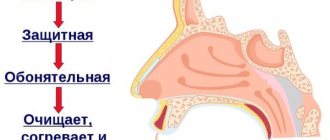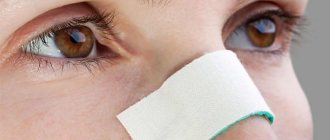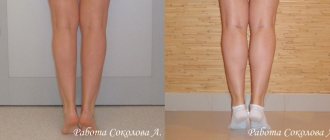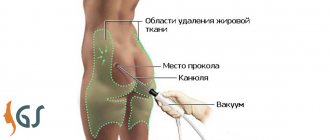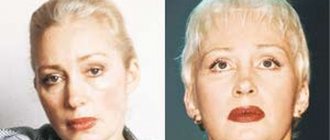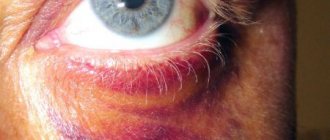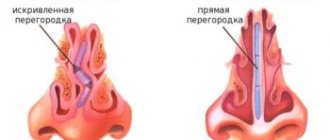Structure and functions of the nasal septum
The nasal septum consists of three parts: bone (it is located quite deep inside the nasal cavity and consists of bones), cartilaginous (in the form of a quadrangular cartilage) and mobile (the area from the skin between the nostrils to the cartilaginous part).
The nasal septum divides the nasal cavity into two nasal passages, thereby determining the uniformity of air flow during breathing. It also performs important supporting and formative functions - it is directly involved in giving a certain shape to the nose, especially its apex and lower surface.
Structure and anatomy
This structure consists of cartilaginous and bone sections. The cartilaginous part forms the anterior zone of the septum, due to which it is more elastic and has relative mobility, especially in the vestibule area. The middle and posterior sections are formed by bone tissue.
The final formation and ossification of the septum occurs by 10-12 years, after which it continues to grow only due to the bone zones. These two sections grow differently, so ridges and spines often appear at the junction of cartilage and bone.
Causes of development of a deviated nasal septum
Physiological – occurs as a result of disharmonious development of parts of the nose at a young age. Most often, non-traumatic curvature takes the form of a complete displacement towards the entire septum, thickening ridges, or outgrowths-spikes.
types of deviated nasal septum
Traumatic – occurs as a result of external, most often mechanical, impact. In most cases, the injury combines damage to the structures of the nasal septum itself and the bones of the nose, which causes a significant cosmetic defect and requires septoplasty of the nasal septum in combination with rhinoplasty.
Compensatory (adaptive) - occurs when in the nasal cavity there is some kind of formation outside the septum itself, exerting pressure on the latter. In this situation, surgery on the nasal septum is combined with surgery to eliminate the cause of the deviated nasal septum.
Tumors of the nasal septum - and this is not always cancer; in most cases, tumoral curvature of the nasal septum is caused by polyps, benign tumors.
Duration of the rehabilitation period after correction of the septum
On the first day after surgery on the nasal septum, difficulties arise with breathing in the usual way. The patient has to inhale air through the mouth and will have to get used to this. Within 1-3 days, tampons are removed from the operated nose, and normal respiratory activity is restored. The procedure for removing tampons is considered quite unpleasant, since they can stick to the mucous membrane and become a source of pain. In order to avoid such discomfort, it is necessary to first soak the tampons with hydrogen peroxide on both sides.
10 days after surgery to correct the nasal septum, the patient is usually prescribed nasal drops to prevent the formation of crusts. In fact, it is necessary to drip such medications, since such a procedure is considered one of the important stages of the recovery period. Such drops help moisturize the nasal mucosa and eliminate crusts. Often at this recovery stage, Nasonex spray is prescribed, thanks to which it is possible to reduce tissue swelling and restore breathing. It is possible to speed up the healing of the nasal mucosa with the help of saline or oily liquid, which must be instilled into the organ.
Rehabilitation after surgery to correct the nasal septum usually lasts 2-3 weeks and after its completion the person can return to their normal life. The duration of the rehabilitation period after surgery to correct the nasal septum is determined by the characteristics of the patient’s tissues, but on average it lasts about a month. The final assessment of the result obtained is carried out several months after surgery.
Indications for surgical treatment
There are often cases when a person has a number of symptoms, sometimes severe, and does not even suspect that the cause of his troubles is a deviated nasal septum. The decision to use surgical treatment is made in the presence of severe symptoms:
- Cosmetic defect - this includes a crooked nose, a hump, a depression, or simply an irregular shape of the nose;
- Constant runny nose - frequent mucous discharge from the nose;
- Chronic nasal congestion on one or even both sides, which can be manifested by breathing through the mouth;
- Feeling of dryness in the nose and mouth;
- Noisy breathing during sleep;
- Snoring, often very strong;
- Frequent nosebleeds, sometimes for no apparent reason;
- Allergic reactions up to manifestations of bronchial asthma;
- Frequent colds;
- Frequent and chronic inflammatory diseases of the paranasal sinuses - maxillary, frontal and others;
- Headache;
- Increased fatigue, decreased attention and performance, memory impairment;
- Reduced sense of smell.
It should also be taken into account that in the presence of a pronounced curvature of the nasal septum and the absence of the above symptoms, it makes sense to perform surgical straightening of the nasal septum, since, especially at a young age, compensatory and adaptive mechanisms are able to neutralize the clinical manifestations. With age, the body's adaptive abilities, which previously coped with the task, are depleted, and symptoms begin to increase, and performing surgery at a more mature age is not always possible due to the general condition of the organs and systems.
Indications for surgery and methods of its implementation
Surgery on the nasal septum is resorted to only in situations where it disrupts a person’s normal life and provokes the development of various complications. Experts identify the following indications for septoplasty:
- constant nasal congestion, which has nothing to do with an allergic reaction or a cold;
- middle ear complications;
- inflammation of the paranasal sinuses of a chronic nature, when the curvature disrupts the normal outflow of air from the sinus.
- If there is a serious displacement, it is recommended to perform surgery to straighten the nasal septum at a young age and not wait for problems to develop.
In some patients, a pronounced displacement is detected, but the second half of the nose breathes quite normally. People with this pathology adapt to this condition and do not complain about breathing problems. With age, the compensatory capabilities of tissues decrease, and patients begin to complain about their condition. However, a doctor is unlikely to take responsibility for performing septoplasty in old age, even if there are a number of indications. It is for this reason that only a specialist decides whether it is worth performing an operation in case of pronounced displacement and absence of complaints.
The following contraindications to septoplasty are identified:
- acute diseases and exacerbations of chronic pathologies;
- menstrual bleeding in women;
- problems with blood clotting;
- psychological diseases and various deviations;
- severe pathologies of internal organs in the stage of decompensation.
Septoplasty is performed in the otolaryngology department using local or general anesthesia. In order for recovery after surgery to go smoothly and without complications, it is necessary to follow all the doctor’s recommendations and carry out certain measures.
Preparing for surgery
If a decision is made to perform surgery for a deviated nasal septum, a number of routine medical tests are prescribed to assess the general condition of the body and the presence or absence of contraindications for anesthesia and surgical treatment:
- General blood analysis;
- General urine analysis;
- Blood chemistry;
- Blood testing for the presence of HIV infection, viral hepatitis and syphilis;
- Coagulogram – determines the state of the blood coagulation system;
- Blood sugar level;
- Electrocardiography;
- Fluorography.
Sometimes, if necessary, the doctor expands the list of laboratory tests and makes appropriate prescriptions.
Immediately before the operation you should:
- Shave your mustache if you have one;
- Avoid drugs that reduce blood clotting (for example, aspirin, cardiomagnyl, heparin, Plavix, warfarin, diclofenac, indomethacin and others);
- You should also refrain from drinking alcohol and limit smoking.
Preparing patients before surgery: examinations and tests
Like any surgical intervention, correction of a deviated septum requires serious preoperative preparation :
- X-ray of the paranasal sinuses or CT (computed tomography). In order to clarify the condition of the paranasal sinuses and the structural features of the nasal cavity.
- General clinical blood and urine tests, blood sugar tests.
- Blood chemistry.
- Coagulogram (blood clotting indicators).
- Blood test for group and rhesus.
- Fluorography and examination by a therapist.
- Tests for syphilis, HIV and hepatitis.
If the patient has concomitant diseases, then a specialized specialist should give his recommendations on the possibility of surgical intervention.
Important
The exact list of studies and tests will depend on the clinic to which the patient applied.
What other requirements must the patient fulfill:
1
The operation is not performed during acute or exacerbation of chronic infections. If a person gets sick or an old disease has worsened, he needs to be treated, recover for 2-3 weeks, and only then undergo septoplasty.
2
In women, surgery is not performed during menstrual bleeding, immediately after it, or before it. It is necessary to time it so that the offset correction is performed approximately in the middle of the cycle.
3
A week before leveling the cartilage plate in the nose, stop taking anticoagulants and non-steroidal anti-inflammatory drugs, as they affect blood clotting.
Contraindications for surgical treatment
Surgery for a deviated nasal septum does not have any specific contraindications, which means that if a person can undergo any significant surgery, then he can also undergo septoplasty. But there are still certain contraindications:
- Age: over 50 years old, and also under 16-18 years old. This is due to the fact that after 50 years, atrophy of the mucous membrane occurs and it “loses” somewhat, which leads to the restoration of normal air flow through the nasal passages and, as a consequence, the pointlessness of the operation. At the age of under 16-18 years, surgical interventions on the cartilage and bones of the nose are undesirable, since until this age the growth of both cartilage and bone elements often remains, which can lead to the futility of the treatment. However, in the presence of pronounced defects and symptoms, surgery can be performed both from the age of six and after 50 years;
- The presence of an acute or aggravated chronic inflammatory disease;
- Presence of menstruation and the first week after it;
- Mental illnesses;
- Coagulopathies are blood clotting diseases;
- Decompensation of chronic somatic diseases;
- Tuberculosis of the lungs and upper respiratory tract;
- Severe atrophy of the epithelium of the nasal septum.
Indications
- nose fracture;
- difficulty breathing due to injury or illness;
- chronic nosebleeds;
- heavy snoring;
- dryness of the nasal cavity;
- chronic nasal diseases (sinusitis, rhinitis, pharyngitis, etc.).
The difference between surgery to straighten the nasal septum (septoplasty) and rhinoplasty lies in the purpose of the operation. When performing surgery to straighten the nasal septum, plastic surgeons at our clinic, if necessary, simultaneously improve the appearance of the nose. And if there are indications, during aesthetic rhinoplasty, nasal breathing must be restored (rhinoseptoplasty).
A beautiful nose must breathe - this is the rule of any competent rhinosurgeon
What causes a deformed nasal septum?
- Anatomical features of the structure of the congenital septum;
- Injuries, nasal diseases, unsuccessful surgery;
- Excessive or abnormal growth of the osteochondral plates of the nose.
How is the operation performed?
A crooked nasal septum does not always lead to difficulty in nasal breathing and surgical intervention. However, if there are clear indications, the choice of a surgeon must be approached extremely responsibly.
Surgery to correct the nasal septum is performed under local or general anesthesia. The duration of the correction is about 1.5-2 hours.
During the operation, the rhinosurgeon makes internal incisions in the nose, peeling off the mucous tissue from the osteochondral structures of the nose. Next, the protruding part of the cartilage or bone tissue, which is the cause of difficulty breathing, is removed. In some cases, a plastic surgeon needs to cut off the cartilage, adjust it and “put” it back.
An example of nasal septum surgery
Anesthesia
Depending on where the curved area is located, the operation is performed using local anesthesia or general anesthesia (anesthesia).
Local anesthesia when straightening the nasal septum is performed when the curvature of the septum does not affect the bone part, but is localized only in the movable or cartilaginous part of the nasal septum - in these areas, the mucous membrane is irrigated with an anesthetic, or tampons soaked in an anesthetic are applied and, after complete loss of all types of sensitivity, start the operation.
When the curvature involves bone structures, or septoplasty of the nasal septum is only a part, or a stage of an extensive operation, then the patient receives general anesthesia. Children are also operated on in a state of anesthesia.
Contraindications
Septoplasty is not performed if the following ailments are present:
- poor blood clotting;
- pathological changes in the body (for example, diabetes, heart failure, etc.) that arose as a result of a long course of the disease or an acute disorder;
- mental disorders, genetic abnormalities.
The patient's age is one of the significant contraindications. Septoplasty cannot be performed until adulthood, however, in emergency cases, specialists correct the septum starting from 6–8 years.
In adulthood (50 - 60 years old), they also try to avoid surgical intervention, but if the patient’s health is normal and there are serious problems that cannot be eliminated without septoplasty, the doctor decides to take risky actions.
In what cases is nose tip correction with fillers indicated and how effective is the procedure? See here photos of patients after correction of the nasolacrimal groove with fillers.
A video of septoplasty of the nasal septum is available at this address.
Methods of surgical treatment
Classic nasal septum surgery has been used since 1882. Naturally, over such a long period of time, enormous clinical experience has been accumulated, a great many modifications of surgical treatment have been developed, and at the moment time-tested techniques are used, which, in combination with modern technological innovations, are almost guaranteed to give a positive effect and cause a minimum number of complications.
Submucosal resection of the nasal septum
Killian's operation: The entire operation is performed inside the nasal cavity, that is, no incisions are made on the side of the facial skin and, as a result, the possibility of postoperative scars forming on open areas of the face is excluded.
submucosal resection of the nasal septum according to Killian
The essence of this operation is that inside the nasal passages, often under endoscopic control (then the operation is called endoscopic septoplasty), incisions are made in the mucous membrane of the nasal septum and perichondrium on both sides alternately. From the level of the roof of the nose to its bottom. In this case, a small sharp scalpel with a rounded, non-pointed tip is used, since the sharp end of the scalpel can easily cut through the entire thickness of the cartilage, as well as the perichondrium and the mucous membrane of the opposite nasal passage. The mucous membrane and perichondrium are dissected down to the cartilage.
Next, an anesthetic is injected under the perichondrium, after which, very carefully, so as not to damage the mucous membrane itself, through the incisions made, the mucous membrane is peeled off along with the perichondrium and periosteum to the required level.
If there is a ridge or spine of the septum, the detachment is performed bypassing it from the side of the roof and the bottom of the nasal passage, so as not to damage the mucous membrane in the area of maximum elevation of the defect. Detachment is carried out beyond the deformed part of the septum. Next, the nasal septum is straightened mechanically: the spines and ridges are cut off, the curvatures are excised, and both cartilage and bone can be corrected.
After leveling, the nasal septum is immobilized using tampons, the previously exfoliated mucous membrane, perichondrium and periosteum are pressed against the cartilage and bones using the same tampons. Often after surgery, wearing a sling bandage is indicated.
Conservative modifications of submucosal resection of the nasal septum proposed by V. I. Voyachek:
septal regression
Redressing the septum: The incision is made in the same way as in the case of Killian's operation, but only from the side of one nasal passage. Next, the perichondrium and periosteum are separated only on the side of the incision, and on the same side, four dissections are made directly on the cartilage itself so that the curved part of the cartilage is not connected to anything other than the mucous membrane, perichondrium and periosteum of the adjacent nasal passage. Using the same principle as with the cartilaginous part, the bony base of the nasal septum is dissected in the area of its curvature. As a result of the manipulations performed, the nasal septum becomes mobile and, without third-party intervention, takes on a natural position. After that, tampons are inserted into the nasal passages in the same way as during Killian's operation.
Mobilization of the septum: The essence and methodology of this modification is absolutely identical to regression, but affects exclusively the cartilaginous part of the nasal septum, without touching its bone part.
Circular resection: If, during mobilization of the septum, the cartilaginous quadrangle does not acquire sufficient mobility to establish the nasal septum in its natural position, then the incisions made are expanded by excising thin strips of cartilage.
Partial resection is a combination of the above modifications of operations on the nasal septum proposed by V.I. Voyacek.
Resection-reimplantation is a modification of the above surgical interventions, which involves excision of a curved fragment of cartilage, giving the excised area the correct shape and returning it back between the layers of the mucous membrane of the nasal septum.
Types and methods of septoplasty
Each septum is unique, so various modifications of the classic operation are used.
In addition, the development of modern technologies has made it possible to correct deformity using a laser and using an endoscope.
There are many types of classical septoplasty: redressing, gentle and circumferential resection, and others. All these types of surgical interventions differ in the amount of cartilage left behind.
Laser nasal septum straightening
There are two ways:
1
Septochondrocorrection with laser. Conducted in a clinic setting. The laser heats the cartilaginous part of the septum, the cartilage becomes soft and plastic. It is given the desired shape and secured with tampons.
This is a bloodless, low-traumatic intervention that can only help with curvatures in the cartilaginous part. For many patients it is not suitable, since problems arise specifically with the bony part of the septum.
2
Laser septoplasty. It proceeds in the same way as a classic operation, but instead of a scalpel, a laser beam is used, which immediately cauterizes the vessels and reduces blood loss.
What does endoscopic septal realignment mean?
Carrying out the operation under an endoscope (special video equipment) allows you to examine in detail and carefully examine the curvature in the deep parts of the nose.
It is rarely used in conventional septoplasty. It is more often used when combining several types of surgical interventions, for example, if it is necessary to perform septoplasty and sinusotomy.
Laser septoplasty
The method is based on a phenomenon discovered in 1992, the essence of which is that under the influence of a laser beam with certain characteristics, cartilage retains its previously given shape. The course of this operation includes mechanical straightening of the cartilage, bringing the laser to the site of the former curvature and laser exposure to this area through the mucous membrane, after which the cartilage retains its correct shape.
Laser septoplasty has a number of undeniable advantages:
- There are no incisions - the laser is applied without damaging the mucous membrane.
- The operation is absolutely bloodless.
- There is absolutely no risk of infectious complications, as well as the formation of hematomas.
- Can be performed on an outpatient basis - there is no need for a hospital stay.
- No postoperative swelling.
- Very short period of postoperative rehabilitation.
The use of a laser to straighten the nasal septum has a number of limitations and cannot be used in all cases. Firstly, this is due to the fact that the laser acts only on cartilage; therefore, treatment of defects in the bony part of the nasal septum is excluded. And, secondly, the laser can only preserve the shape of the cartilage given in advance, but it is not able to remove a ridge or spike. The laser is also ineffective if the curvature of the cartilage of the nasal septum is associated with compensatory reasons, which are described above.
The choice of any of the described surgical treatment options is dictated primarily by the prevalence and severity of the curvature of the nasal septum, as well as the technical capabilities of the clinic you contacted.
How to straighten the nasal septum: septoplasty
The operation is performed in the otolaryngology department. The night before the intervention, the patient should not eat, but is allowed to drink some water.
Septoplasty can be performed under local anesthesia (anesthesia) or general. Both types of anesthesia have their advantages and disadvantages, so this issue must be resolved together with the attending doctor, who knows the specifics of the problem and the presence of concomitant diseases.
If the patient has chosen local anesthesia, then an hour before the operation he is given sedatives.
How the operation itself is performed
Classic septoplasty goes like this:
- The doctor numbs the nasal cavity with an anesthetic solution (lidocaine and others).
- Using a syringe, injects an anesthetic solution into the mucous membrane.
- An incision is made on the most curved side and begins to slowly peel off the mucosa and perichondrium, continuing to numb the pain as necessary.
- Isolates nasal cartilage and removes it. Then it reaches the bony part of the septum.
- Use a chisel or hammer to knock down the ridge or spike that caused the curvature.
- The incision is sutured and gauze swabs are placed in the nostrils, which fix the septum in the middle position and help stop bleeding.
Important
The intervention itself lasts on average about an hour, depending on the type of anesthesia and the characteristics of the patient’s septum.
Rehabilitation
In the case of laser septoplasty, rehabilitation is practically not required due to the low traumatic nature of the method.
When performing classical septoplasty, in most cases a hospital stay of up to seven days is required.
In the first few days, there are gauze swabs in the nose, which prevent nasal breathing. In many clinics, ancient gauze tampons are replaced with silicone tampons or a special gel, which perform the same functions as gauze tampons, but contain special channels inside that allow nasal breathing to be maintained even in the early postoperative period, which significantly improves the quality of life during rehabilitation.
As soon as the time comes—approximately the second or third day, depending on the type of operation performed—the tampons are removed and the nasal passages are examined to monitor their condition. During a hospital stay, crusts are removed with the participation of medical personnel very carefully so as not to damage the injured mucous membrane of the nasal cavity.
During the recovery period, anti-inflammatory and painkillers are often prescribed to alleviate the patient's condition. In order to prevent infectious complications, antibacterial drugs are prescribed; their use can be either systemic (tablets, injections) or local - irrigation of the nasal mucosa.
After discharge from the hospital, before starting work, you must visit an ENT doctor at the clinic to monitor the condition of the nasal cavity. In most cases, if the work does not involve intense physical activity, you can start working after 10-14 days.
In order to prevent complications in the postoperative period, it is necessary:
- Avoid drinking hot food and drinks;
- Refrain from visiting the bathhouse, solarium;
- Limit the amount of time you spend in the sun;
- Protect yourself from intense physical activity.
Causes of a deviated nasal septum
According to statistics, people with a perfectly straight septum are almost never found. In the majority of the population, it has varying degrees of thickening, spines and bends.
This deformity is diagnosed already in adolescence, when the child is rapidly growing. What can cause this problem:
- Uneven growth of different parts of the septum is the most common cause.
- Traumatic injury that causes deformity.
- Compensatory curvature in the presence of chronic hypertrophic rhinitis, tumor or foreign body in the nasal cavity.
- Congenital curvature associated with trauma during passage through the birth canal or abnormal development of the skull bones in the prenatal period.
Interesting
The second most common cause is a nose injury, and most people don't even remember how they got it. Such bruises and injuries are regularly found in children; they do not show any symptoms other than slight swelling, and then heal on their own, causing the appearance of deformities and bone spikes.
Types of curvatures
Patients often do not understand that if almost all people have a deviated septum, then is it worth paying attention to it and how dangerous such a condition can be.
Although such deformation is common, problems can only arise when it interferes with normal physiological nasal breathing. What can this condition lead to:
1
Chronic inflammation of the nose and paranasal sinuses. The curved area irritates the mucous membrane, causing its swelling and compensatory growth. The outlets of the sinuses swell and stop working normally - all this leads to the constant maintenance of the inflammatory process in the nasal cavity.
2
Violation of olfactory sensations. Prolonged congestion and swelling lead to atrophy of the olfactory nerve, and the person begins to faintly distinguish odors.
3
Frequent headaches. The lack of full nasal breathing causes disruption of the normal blood supply to the brain. A person is worried about headaches, lethargy, and drowsiness.
4
Development of chronic atrophic processes in the oropharynx (pharyngitis, laryngitis, etc.). If the patient does not breathe through his nose, he begins to breathe through his mouth, the mucous membrane of which is not intended for inhaling cold, unpurified air. The back wall of the pharynx begins to dry out and become inflamed, which leads to illness.
5
Hearing and ear problems. The nose is connected to the ear by a special eustachian tube; through this tube, air enters the ear, which equalizes the pressure in the middle ear.
When the septum in the nose is deformed, the mucous membrane swells and clogs the outlet of this tube. A person is worried about stuffy ears, and otitis media often develops against this background.
6
Snoring and attacks of night suffocation.
Source: nasmorkam.net
Complications
This type of surgical intervention has been worked out in quite detail and the development of complications is a rare occurrence. Postoperative complications may manifest as follows:
- Formation of a hematoma - a tense cavity filled with blood between the cartilaginous or bone parts of the septum and the nasal mucosa;
- Bleeding from the nose;
- Perforation of the nasal septum - the formation of a canal connecting the two nasal passages;
- Inflammatory complications in the form of ulcers;
- Sinusitis, sinusitis, and other sinusitis;
- Synechiae - adhesions inside the nasal passages;
- Decreased sense of smell;
- Deformation of the nose in the form of retraction of its back.
External manifestations and internal symptoms
If a person has a deviated nasal septum, the following symptoms are possible:
A chronic runny nose appears.
Trouble breathing through the nose. It can be light or heavy, to the point that a person breathes only through the mouth. The absence of this symptom does not exclude the presence of a defect.- Chronic runny nose. Occurs as a result of impaired ventilation and proliferation of microbes.
- Frequent allergic reactions.
- Congestion.
- Swelling of the mucous membrane.
- Headache. It occurs against the background of congestion, complications in the form of sinusitis (sinusitis), increased pressure on the mucous membrane and irritation of the receptors.
- Frequent episodes of ARVI. Manifested by coughing, sneezing, and fever.
- Dry mucous membranes.
- Nosebleeds.
- Sleep apnea. Attacks of respiratory arrest during sleep.
- Snore.
- Sleep disturbance.
- Asthenic manifestations in the form of decreased performance, lethargy, weakness. The reason is oxygen deficiency.
- Change in the shape of the nose (deviation, depression of the back).
- Deterioration of attention and memory.
Less commonly observed symptoms are cough, tickling, decreased sense of smell, tinnitus, dryness, nasal tone, change in facial expressions (open mouth, change in bite).
Where can I have the operation and how much does it cost?
Most large hospitals in public and private clinics with ENT departments perform this operation.
The free way to a straight nasal septum is through an ENT doctor at the regional clinic to which you belong. The doctor will issue a referral to the hospital, where you will be put on a waiting list and after the necessary examinations and after a certain period of time, you will undergo septoplasty. If you go this route, there are two disadvantages - time and the qualifications of the operating doctor, which may or may not be the highest. Fortunately, there are not so many very young doctors, and novice surgeons always work under the guidance of their more experienced colleagues.
The cost of a classic operation, including hospital stay, ranges from 20,000-100,000 rubles. It is worth considering here that the price is often inflated, citing the use of laser and wave scalpels, however, given the small incisions inside the nasal passages, the use of such expensive equipment looks doubtful. Laser septoplasty is much more expensive and prices range from 40,000-30,0000 rubles.
Where is the best place to have septum plastic surgery?
In public clinics, correction of the nasal septum is carried out using the Killian method. It is worth mentioning that this is an outdated technique, it is quite traumatic.
In recent decades, many modern minimally invasive techniques have appeared that can reduce the rehabilitation period:
- endoscopic septoplasty;
- laser
All these types of interventions are not carried out under the compulsory medical insurance policy.
It is up to the patient to decide which clinic to go to, paid or free. Money is on one side of the scale, health is on the other. Of course, if there are no financial possibilities, then there is no choice, but if there is money, then it is better to do the operation for a fee. Plastic clinics that do not operate under compulsory medical insurance have the latest equipment, which can be used to perform interventions with the least amount of tissue damage.
If you decide to save money, you need to do the following:
- Visit an ENT specialist.
- Get tested.
- Receive a referral on Form 057 for surgery.
Related article: Is removal of papillomas included in the compulsory medical insurance policy
? The surgeon decides what type of anesthesia to choose, local or general.
Note! You can get septoplasty under compulsory medical insurance at the National Medical Research Center of Otorhinolaryngology "FSBI NMITSO FMBA of Russia", at the Institute of Otorhinolaryngology named after. L. I. Sverzhevsky.
In general, we would like to note that free does not mean bad. The main thing is to choose a qualified surgeon, then the operation will be successful.
Video on the topic of the article
Result
According to reviews, in the vast majority of cases, after surgical intervention on the nasal septum, the above-described clinical manifestations are the first to go away, and they disappear completely, and you will be able to breathe through your nose! In addition, the frequency, severity and duration of infectious diseases - acute respiratory viral infections, acute respiratory infections, rhinitis, sinusitis and others - are reduced.
Naturally, surgery is a serious step and you need to evaluate and weigh the pros and cons, having first suppressed your fear, but the result of this operation usually exceeds expectations, and after two to three weeks patients note the absence of previously disturbing nasal symptoms and a significant improvement in quality life in general.
